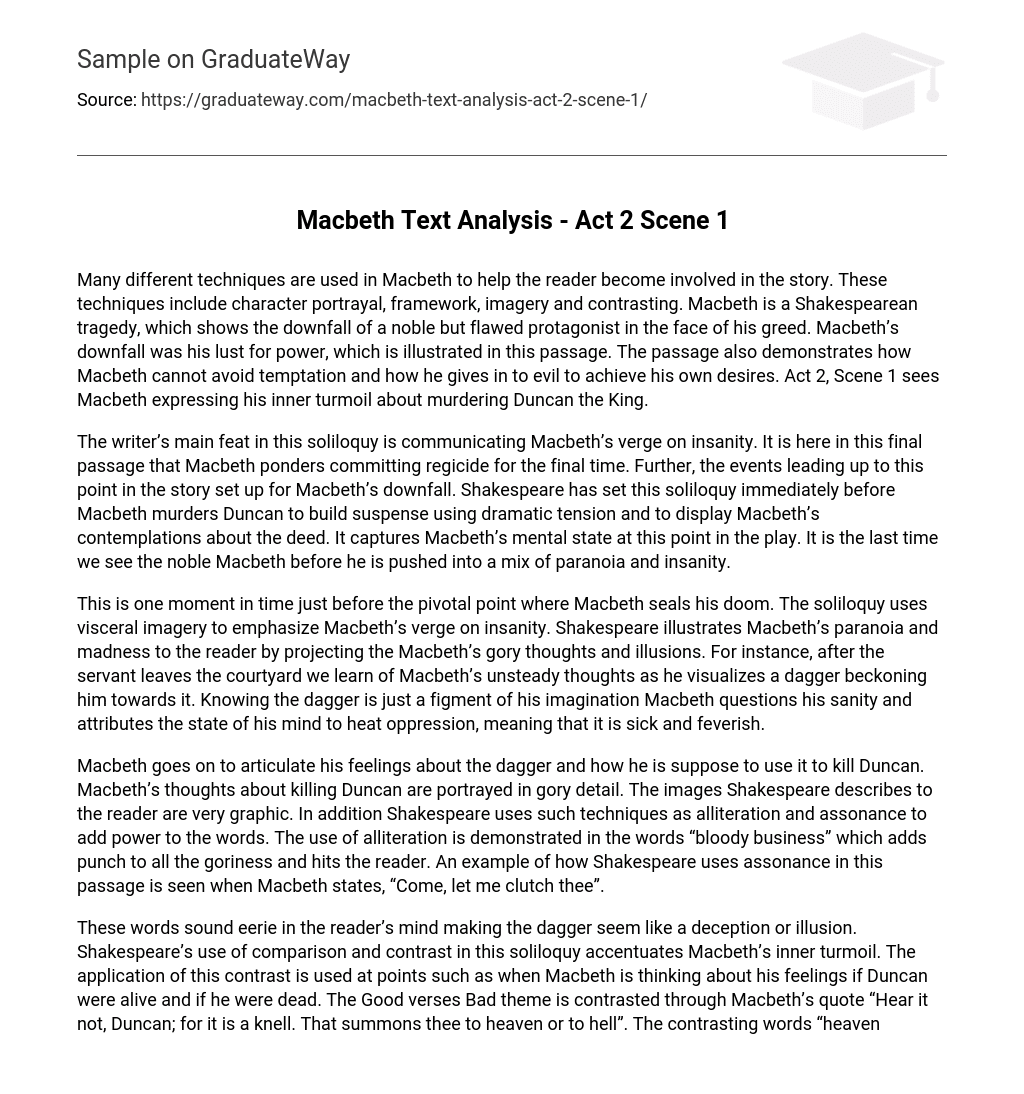Many different techniques are used in Macbeth to help the reader become involved in the story. These techniques include character portrayal, framework, imagery and contrasting. Macbeth is a Shakespearean tragedy, which shows the downfall of a noble but flawed protagonist in the face of his greed. Macbeth’s downfall was his lust for power, which is illustrated in this passage. The passage also demonstrates how Macbeth cannot avoid temptation and how he gives in to evil to achieve his own desires. Act 2, Scene 1 sees Macbeth expressing his inner turmoil about murdering Duncan the King.
The writer’s main feat in this soliloquy is communicating Macbeth’s verge on insanity. It is here in this final passage that Macbeth ponders committing regicide for the final time. Further, the events leading up to this point in the story set up for Macbeth’s downfall. Shakespeare has set this soliloquy immediately before Macbeth murders Duncan to build suspense using dramatic tension and to display Macbeth’s contemplations about the deed. It captures Macbeth’s mental state at this point in the play. It is the last time we see the noble Macbeth before he is pushed into a mix of paranoia and insanity.
This is one moment in time just before the pivotal point where Macbeth seals his doom. The soliloquy uses visceral imagery to emphasize Macbeth’s verge on insanity. Shakespeare illustrates Macbeth’s paranoia and madness to the reader by projecting the Macbeth’s gory thoughts and illusions. For instance, after the servant leaves the courtyard we learn of Macbeth’s unsteady thoughts as he visualizes a dagger beckoning him towards it. Knowing the dagger is just a figment of his imagination Macbeth questions his sanity and attributes the state of his mind to heat oppression, meaning that it is sick and feverish.
Macbeth goes on to articulate his feelings about the dagger and how he is suppose to use it to kill Duncan. Macbeth’s thoughts about killing Duncan are portrayed in gory detail. The images Shakespeare describes to the reader are very graphic. In addition Shakespeare uses such techniques as alliteration and assonance to add power to the words. The use of alliteration is demonstrated in the words “bloody business” which adds punch to all the goriness and hits the reader. An example of how Shakespeare uses assonance in this passage is seen when Macbeth states, “Come, let me clutch thee”.
These words sound eerie in the reader’s mind making the dagger seem like a deception or illusion. Shakespeare’s use of comparison and contrast in this soliloquy accentuates Macbeth’s inner turmoil. The application of this contrast is used at points such as when Macbeth is thinking about his feelings if Duncan were alive and if he were dead. The Good verses Bad theme is contrasted through Macbeth’s quote “Hear it not, Duncan; for it is a knell. That summons thee to heaven or to hell”. The contrasting words “heaven” and “hell” highlighting the good and bad aspects of Duncan’s behavior.
Throughout the play, the reader unearths that all is not what it seems. This main theme in Macbeth is carried on throughout this soliloquy. To promote this theme Shakespeare uses oxymorons to display this disharmony. In the soliloquy Macbeth quotes “Nature seems dead”. However, the ever-evolving way of nature means that it is ever continuing and therefore cannot be considered dead. Furthermore yet another oxymoron is used to show how evil is taking over. This is seen through the expression of the phrase “wicked dreams”.
Dreams are normally associated with peace and harmony. Thus the thought of “wicked dreams” is quiet unsettling. Shakespeare successfully employs writing techniques such as character portrayal, framework, imagery and contrasting for dramatic affect. Imagery is used throughout the soliloquy to create mood and to show Macbeth’s fall into insanity and rising anger. Shakespeare’s writing techniques clearly characterize the author’s style creating a sense of tension, drama and intrigue that captivates the reader or audience of the play.





